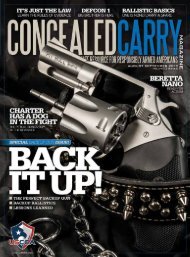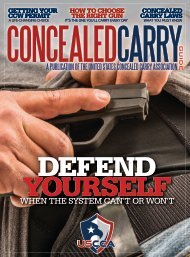Download This Issue - US Concealed Carry
Download This Issue - US Concealed Carry
Download This Issue - US Concealed Carry
Create successful ePaper yourself
Turn your PDF publications into a flip-book with our unique Google optimized e-Paper software.
Support hand practice with<br />
laser sights. Aim point is<br />
high center of mass.<br />
Trigger<br />
finger in<br />
the register<br />
position.<br />
Make sure you have a safe<br />
backstop and that there is no live<br />
ammunition in the room.<br />
In Dry Practice Exercise Three, you<br />
practice ten repetitions of acquiring<br />
your sight picture and fully working<br />
the trigger. If your handgun is a double<br />
action revolver or a double action only<br />
(DAO), trigger cocking, semi-automatic<br />
pistol with a hammer—such as the DAO<br />
Sig Sauer, Heckler & Koch, and Smith<br />
& Wesson pistols, you can simply and<br />
easily dry practice double taps. A double<br />
tap refers to firing two shots in rapid<br />
succession. On the other hand, if your<br />
semi-automatic pistol is like a Glock<br />
or Springfield Armory XD series pistol,<br />
you must manually cycle the slide to<br />
simulate the gun’s slide cocking action<br />
in order to dry practice double taps and<br />
trigger reset drills.<br />
Keep in mind that you can set up your<br />
favorite range targets at home against<br />
a safe backstop and conduct these<br />
dry practice drills. I like to follow Jack<br />
Weaver’s advice quoting from the May/<br />
June 2008 issue of American Handgunner<br />
(page 109): “Your [dominant] eye, the<br />
back sight, front sight and the target<br />
don’t have to be perfectly lined up,” he<br />
says, bending his head down slightly<br />
and bringing the gun up to eye level,<br />
“but you can see the sights, and as you<br />
squeeze the trigger, you correct them<br />
as best you can. Pretty soon, you get to<br />
the point where you come pretty close<br />
every time.” (www.weaverstance.com)<br />
Practice, practice, and practice.<br />
Safe Room<br />
Dry Practice<br />
Another exercise that you can do at<br />
home is to simulate working within<br />
your safe room. I am talking about<br />
visualizing home invaders breaking<br />
into your safe room. First, unload your<br />
home defense handgun. Triple check<br />
it and sequester all live ammunition.<br />
The sequence entails verbalizing<br />
appropriate commands from behind<br />
cover: “STOP! DROP YOUR WEAPON!<br />
I’M ARMED. GO AWAY! LEAVE THIS<br />
HO<strong>US</strong>E NOW!” Acquire a sight picture<br />
on your imaginary home invader and<br />
dry fire if necessary. You should practice<br />
this drill with your trigger finger in<br />
register, taking up the trigger slack,<br />
and both with, and without dry firing.<br />
Remember, you hope that you do not<br />
have to fire, but you must be prepared to<br />
do so if the threat does not back down.<br />
Perceptual Awareness<br />
Learn to really notice and study<br />
your targets. Practice tracking multiple<br />
targets. <strong>This</strong> involves scanning and<br />
verifying each target in an array. As you<br />
verify each target, you establish an aim<br />
point and acquire your sight picture.<br />
<strong>This</strong> type of practice builds your visualperceptual<br />
and observational awareness<br />
skills. It also transfers to live fire drills.<br />
Live Fire Drills<br />
I try to get to the range for skills<br />
maintenance practice at least twice<br />
a month. When I go, I try to make the<br />
most of my time and ammunition. With<br />
my carry handgun or home defense<br />
handgun, I have found the following live<br />
fire drill to be an excellent way to keep<br />
my skills intact. The drill incorporates<br />
multiple skills: stance, grip, draw from<br />
concealment, trigger control, sight<br />
alignment and sight picture, varying<br />
distances, follow-up shots, speed, and<br />
accuracy. It is not a beginner’s drill. It<br />
is not a skills acquisition exercise. It is a<br />
skills maintenance drill. It requires just<br />
50 rounds—one box of ammunition.<br />
It does not require a shot timer. To<br />
52<br />
<strong>US</strong>CONCEALEDCARRY.COM n CONCEALED CARRY MAGAZINE n JULY 2008
















